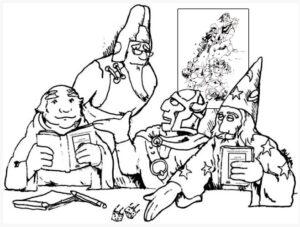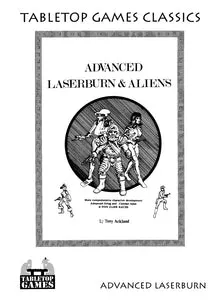Welcome, dear reader, to another edition of “Setting the Record Straight.” I’m your host, Mr. Wargaming, and today we’re talking about 1980’s classic sci-fi skirmish rules, Laserburn.
A false narrative has sprung up among those who discuss the game in the current era. Today, most designers and players pursue that ephemeral and rarely defined goal of “elegance”, and so the telephone game mischaracterizing Laserburn as slow, cumbersome, and difficult to play takes root. Those who played back in the day moved on to newer and better systems, and most frequently parrot the line expected party line of, “We had fun, but it kinda sucked.” A weird thing to say about a game that grandfathered the most financially successful wargame (WH40K) the hobby has seen. There must have been something fun in Bryan Ansell’s ruleset or its acorns would have fallen a lot father from the tree.
It set a standard that would last for two decades by driving deep footprints into the hobby, blazing a trail that most skirmish games followed. It’s a pretty detailed look at modern combat, and forces players to think like modern squad leaders. It features a long list of modifiers, and the combat resolution involves several steps:
- Roll to hit
- Roll for location
- Roll for penetration (read: armor save)
- Roll for damage
 With each step including one or two possibilities outside of the yes/no binary. An armored figure that makes its armor save still might be knocked over or forced to duck back into cover, for example.
With each step including one or two possibilities outside of the yes/no binary. An armored figure that makes its armor save still might be knocked over or forced to duck back into cover, for example.
So let’s dispel some myths.
Figures only have three stats: shooting, fighting, and initiative.
Shooting
It’s a percentile based roll-under system. Granted, there are a number of modifiers, but no more than most skirmish games even lo these four-and-a-half decades later. Even better, there are no range bands. Each firearm has a single modifier for distance; for every centimeter between the figures your to-hit number goes down by 1 to 4. Just having to remember one number instead of three, one each for short/medium/long, streamlines the game.
Fighting
Figures roll d100 and add their fighting skill. Whoever wins runs down the hit location/armor save/effect process mentioned earlier. That wasn’t so bad, was it?
Initiative
The activation system is pretty snazzy. Everybody starts on overwatch – figures can try to shoot at any model appearing in its field of vision even before their number comes up. That takes a reaction roll (2 in 6, or for lightning reflexes 3 in 6), and cuts your shooting skill in half, and whether you succeed or not, your figure is done for the turn.
The initiative order is simple; roll a d10 and add your initiative score. High rollers act first, or save their action for later. They basically go on active overwatch and this can negate the penalty mentioned one paragraph earlier. Once you get down to zero, everybody who hasn’t acted can – and admittedly, here the rules are strangely silent. I’d roll back up through the order, giving low numbers one last chance to act or stay on overwatch, so that high rollers can wait to see the lay of the land before deciding what to do, but that’s just me. You might roll back down through the order one more time.
That’s pretty much it. The rest of the details come into play with weapon and armor selection. The weapons are finely detailed and include a whole lot of optional rules that only factor into play if you let them. If you keep your figures down to a dozen per side, and don’t go overboard with the specialty gimmicks, the game doesn’t bog down any more than a game of Xenos Rampant or it’s descendent, Warhammer 40k.
But don’t take my word for it. Get your own copy for just ten bucks.
Also, the art passes the Jeffro test, so it’s got that going for it.




883sog
Dosage Forms Form Route Strength Capsule, extended release Oral 6 topical propecia If you are undergoing fertility treatment, talk to your doctor about adding CoQ10 to your diet plan
Good day! This is my first comment here so I just wanted to give a quick shout out and say I really enjoy reading your posts. Can you recommend any other blogs/websites/forums that deal with the same subjects? Thanks a ton!
v6ectu
2dw434
gKw RJtrwuqA zNqbuG aCkPP wBRUy kNQMFwZ FNOlJ